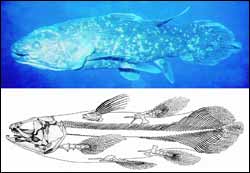Living fossil roams the seas

Latimera - How different are the coelacanth’s genes from those of other fishes and tetrapods? And can the species be useful as a tool for vertebrate comparative genomics?”
Genomics is being used for the first time to investigate the mystery of the ‘living fossil’ fish coelacanth, first dragged up along the coast of South Africa in 1938, having been considered extinct for 65 million years. Because of its close resemblance to land animals, it has attracted attention to the subject of a ‘missing link’ between tetrapods and humans. Dr. Chris Amemiya will be presenting his work on the generation and utilization of genomic resources for the Indonesian coelacanth on Wednesday 13th July at the Society for Experimental Biology Annual Main Meeting in Barcelona [session A5].
These genomic resources make it possible to investigate extended gene regions in order to analyse evolutionary relationships with other animals. Genes of particular interest have been those involved in embryonic development and immunity. “There are two questions we are trying to answer”, explains Amemiya. “How different are the coelacanth’s genes from those of other fishes and tetrapods? And can the species be useful as a tool for vertebrate comparative genomics?”
Media Contact
More Information:
http://www.sebiology.org/vcsearch.aspAll latest news from the category: Life Sciences and Chemistry
Articles and reports from the Life Sciences and chemistry area deal with applied and basic research into modern biology, chemistry and human medicine.
Valuable information can be found on a range of life sciences fields including bacteriology, biochemistry, bionics, bioinformatics, biophysics, biotechnology, genetics, geobotany, human biology, marine biology, microbiology, molecular biology, cellular biology, zoology, bioinorganic chemistry, microchemistry and environmental chemistry.
Newest articles

Superradiant atoms could push the boundaries of how precisely time can be measured
Superradiant atoms can help us measure time more precisely than ever. In a new study, researchers from the University of Copenhagen present a new method for measuring the time interval,…

Ion thermoelectric conversion devices for near room temperature
The electrode sheet of the thermoelectric device consists of ionic hydrogel, which is sandwiched between the electrodes to form, and the Prussian blue on the electrode undergoes a redox reaction…

Zap Energy achieves 37-million-degree temperatures in a compact device
New publication reports record electron temperatures for a small-scale, sheared-flow-stabilized Z-pinch fusion device. In the nine decades since humans first produced fusion reactions, only a few fusion technologies have demonstrated…





















